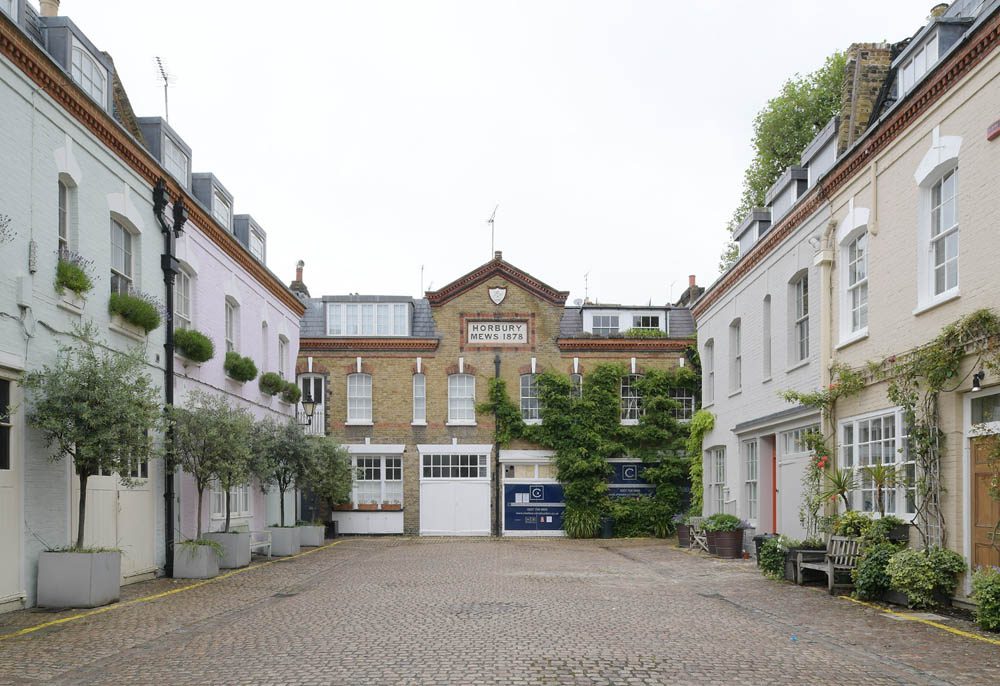How Have Glazing Technologies Advanced to Suit Historic Properties?
Ever pondered whether those charming old windows can keep up with modern energy standards? It’s a question close to the hearts (and wallets) of historic building owners everywhere. It’s especially a hot topic with the UK government’s ambitious goal of achieving Net Zero carbon emissions by 2050.
Historic homes aren’t just quaint relics; they comprise a substantial portion of the UK’s housing stock, accounting for around 20% of the total. Yet, many of these architectural treasures fall short on the energy efficiency front, contributing significantly to carbon emissions. Thus, the imperative to upgrade period properties extends far beyond mere comfort or aesthetics—it’s a pivotal step in the nation’s journey towards a sustainable future.
Navigating the labyrinth of planning permissions and conservation regulations can feel daunting. Suddenly, preserving those gorgeous original windows feels like a tug-of-war between tradition and efficiency. For historic homeowners, this bureaucratic maze can pose a significant barrier to implementing energy-efficient upgrades.
However, the government have recognised the need to streamline the planning process for these homes:
Minister for Housing and Communities Baroness Penn
“Our historic homes are the jewel in the crown of this country’s heritage and must be protected.
This review will ensure they are preserved for future generations to enjoy, while also improve the lives of those who live in them by reducing their energy costs, supporting us in our shared goal to reach Net Zero by 2050.”
Glazing technologies have also evolved to give historic homes a green makeover, all while keeping their timeless charm intact. Let’s debunk some myths, share success stories, and learn how to navigate the maze of planning permissions in conservation areas.
What Options Are Available for Upgrading Windows in Historic Buildings?
Repair Existing Windows
While the most traditional choice is to repair and restore original windows, this approach often falls short in significantly improving energy efficiency. The combination of single glazing and gaps in the construction makes it much more difficult to maintain comfortable indoor temperatures. Who wants to pay higher heating costs to still be cold?
Add Secondary Glazing
Installing secondary glazing involves adding another layer of glass or acrylic inside the existing window. This method preserves the building’s exterior appearance and provides some improvement in thermal insulation and noise reduction, however, this can prove unsightly and make it difficult to reach behind to access the original window.
Upgrade to Double Glazed Windows
Upgrading to modern double-glazed windows can be a viable option. Especially in conservation areas, choosing windows that match the traditional style can sometimes be approved, enhancing both energy efficiency and property value. One option is slim-line double glazing, though vacuum glazing provides a much more efficient and reliable option.
Replace with High-Performance Heritage Windows
For the best blend of historical aesthetics and modern performance, consider replacing old windows with new ones designed to look authentic but built with today’s technology. Our heritage range features timber windows with LandVac vacuum glazing and Accoya frames, offering excellent thermal performance without compromising the historical character of your property.
It is worth noting that there is still regional disparity in planning approval and that what is allowed can be somewhat of a postcode lottery. This is something that is being addressed by the Government.
What are the Government’s Plans to Make Historic Home Planning Permission Easier?
The government has identified several barriers to retrofitting historic homes, such as the complexity and duration of obtaining planning permissions and the special considerations needed for listed buildings and conservation areas. To address these issues, the government plans to:
Simplify the Planning Process:
Introduce clearer policies and guidelines to balance heritage conservation with necessary energy efficiency upgrades. This includes the integration of Local Listed Building Consent Orders (LLBCOs) which streamline the approval process for common retrofits like solar panels.
Increase Funding and Support:
Provide financial support and incentives for homeowners to undertake energy efficiency upgrades. This includes substantial funding allocations for clean heat and energy efficiency improvements.
Strengthen Guidance and Training:
Improve resources for local planning authorities and homeowners to better understand and navigate the regulatory landscape. This includes consultations on modifications to planning policies better to incorporate energy efficiency measures within historic preservation criteria.
Promote Innovative Solutions:
Encourage the use of appropriate and sensitive retrofit measures that align with the historic character of the buildings while enhancing their energy performance.
The review underscores the need for an ongoing dialogue between government bodies, heritage organisations, and homeowners to ensure that the retrofitting of historic homes contributes positively to the UK’s energy efficiency and carbon reduction goals, without compromising their historical integrity. One such solution is vacuum glazing.
Myth-Busting: Concerns About Vacuum Glazing
Misconception 1: Low Average Insulation Values
Why is glass U-Value Measured at the center of the pane?
It is industry standard to measure glass u-value from the centre of the pane to ensure that it is the glazing only (rather than the frame, centre bar or sealant) that is being measured. Frame material, sealant, design, quality of craftsmanship and how tightly the window is fitted all play a part in how much heat escapes, so it makes sense to judge the glass on its own merit rather than other variables.
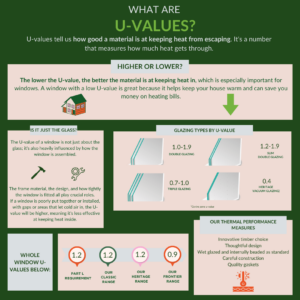
Let’s talk about our Gowercroft Heritage range for an example. Through extensive whole window U-value simulations, we’ve achieved outstanding results by incorporating LandVac vacuum glass.
Despite older buildings not being held to the same regulations as new builds, our range exceeds Part L requirements.
| Window Type | Size (mm) | Whole Window U-Value (W/m²K) |
| Winston Sliding Sash | 1230 x 1480 | Below 1.12 |
| Richmond Two-Light Casement | 1480 x 1230 | Below 1.18 |
Take, for example, our Winston sliding sash window. With a U-value below 1.12W/m²K, this window is a testament to the incredible insulation properties of Accoya® wood and our innovative SashSealer technology, which guarantees BSI Class 4 air permeability standards.
Accoya®’s molecular structure naturally traps air, making it a superior insulator compared to traditional hardwoods and softwoods.
In practical terms, this means that our windows provide exceptional thermal efficiency.
With such impressive performance, our windows not only meet the highest standards but also offer tangible benefits in terms of energy efficiency and comfort for your home.
Misconception 2: Can cause condensation issues
Contrary to the previous misconception that vacuum glazing isn’t efficient enough, some argue that it can cause problems by being too effective. Whilst worries about dew-point changes and interstitial condensation in old buildings are valid, they can be easily solved.
What is a dew point?
GCSE Science 101: When water vapour cools, it turns to water. Dew point is the temperature at which this happens, causing condensation. It is possible for windows and other parts of buildings to be below the dew point, thus accumulating water.
What is interstitial condensation?
Interstitial condensation is when warm water vapour cools as passes through the layers of a building and condenses. E.g. within the walls. This can cause mould and structural deterioration.
Older homes are built with breathable materials: lime-based mortars, stone, slate and timber, meaning that water vapour can pass through freely, but they are also extremely draughty and liable to be cold. Less distinction between inside and outside temperatures means less likelihood of condensation. Upgrading original windows to more efficient windows reduces the air circulation, meaning that water could condense somewhere else. With efficient glass types, this may not be the coldest location in the house, therefore increasing the possibility of interstitial condensation.
You could choose not to upgrade your house and be cold.
Or you could take steps to control the humidity in your home:
- Regularly open your windows to ventilate – especially at opposite ends of your home for cross ventilation.
- Keep your home at a consistent temperature.
- Get the best bathroom extractor fan you can and have it fitted properly.
- Invest in a dehumidifier.
- Consider Positive Input Ventilation
Misconception 3: Incompatible with Georgian Frames
With the development of mechanically fixed integral bars, we are able to give the faithful look of Georgian windows, but with the energy efficiency of vacuum glazing. Our system differs from Planton bars (disliked by planning officers) because they are an integral part of the frame rather than stuck to the glass, meaning they don’t fall off.
Misconception 4: Unsightly Spacers and Delamination
Spacers are crucial in vacuum glazing systems, maintaining the right gap between glass panes for structural strength and thermal efficiency. Fortunately, modern spacer designs have greatly enhanced both their appearance and performance.
One of these windows has vacuum glazing in it. The other doesn’t – can you tell which is which?
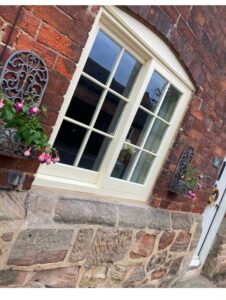
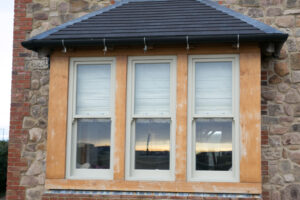
We think this answers any questions about vacuum glazing being noticeable!
Now that we have addressed the look, let’s talk about the rare situation where spacers might drop to the bottom of the unit in vacuum glazing systems. Though it’s not common, manufacturers are always working on improving product reliability.
LandVac have seen few instances of spacers dropping and with rigorous quality control and tech advancements, the chances of spacers dropping are low.
Plus, the 15-year warranty for the units proves you can trust in our product’s durability and reliability.
Misconception 5: High Carbon footprint
Our commitment to sustainability extends beyond the craftsmanship of our windows; it encompasses every stage of their lifecycle, from production to installation. In collaboration with esteemed universities, we’ve conducted comprehensive studies to quantify the carbon footprint of our windows. The findings reveal that despite sourcing vacuum glass from China, meticulous attention to detail ensures that our windows maintain low overall carbon emissions.
Furthermore, our dedication to transparency means that we’re continuously seeking ways to further reduce our carbon footprint and enhance the sustainability of our products. Whether it’s exploring alternative materials or optimising production techniques, we’re committed to pushing the boundaries of eco-friendly innovation.
In essence, our sustainable windows aren’t just a product—they’re a testament to our unwavering commitment to environmental responsibility. By prioritising sustainability at every stage of the window lifecycle and offsetting emissions where necessary, we’re not only reducing carbon emissions but also paving the way for a greener, more sustainable future.
Examples of Successful Energy-Efficient Retrofits in Historic Buildings
Historic preservation meets modern sustainability as we explore real-life examples of successful energy-efficient retrofits in historic buildings. These barely scrape the surface of the historic buildings retrofitted with our Heritage windows:
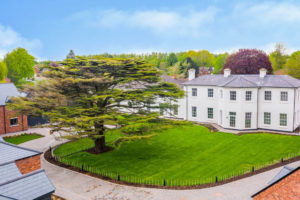
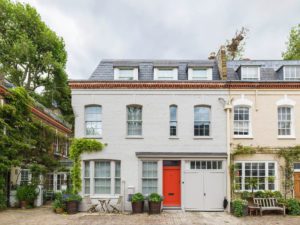

You can see more by viewing our case studies.
How Can Gowercoft Joinery Help Make Your Historic Home More Efficient?
It’s evident that the journey towards energy-efficient retrofits in historic buildings is both promising and necessary.
The success stories shared here are just the beginning. As we strive towards a greener, more sustainable future, it’s crucial to remember that every retrofit, every preservation effort, contributes to a larger, collective goal.
At Gowercroft, we’re proud to be part of this journey, offering our high-performance Heritage windows as a beacon of sustainable innovation in the realm of historic preservation. Contact us today to learn more about how our windows can transform your historic property into a beacon of eco-conscious living.

